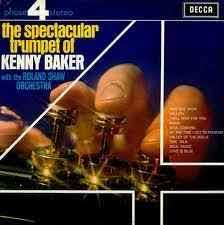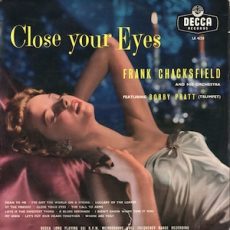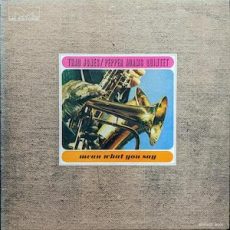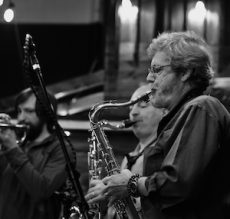
Daily Dose Of Jazz…
Kenny Baker was born on March 1, 1921 in Withernsea, East Riding of Yorkshire, England. Joining a brass band, by the age of 17 he had already become a professional musician. After leaving his home town for London, he met and began performing with George Chisholm. He was first heard on record in a British public jam session in 1941 and quickly established a strong reputation in London clubs.
After serving in the Royal Air Force during WWII, the young Baker was lead trumpeter with Ted Heath’s post war orchestra, with Bakerloo Non-Stop recorded for the Decca record label in 1946. He played a tenor saxophone solo on Johnny Gray, the piece recorded by both Baker and the drummer Jack Parnell. During the 1950s, he led his own group called Baker’s Dozen and performed on the first regular jazz show, the BBC Light Programme series Let’s Settle For Music.
During this period he regularly recorded as a quartet for Parlophone, and in the Sixties and Seventies, he was on call for film and studio work. He shared top billing with comedy variety acts, continued to appear on BBC shows, and formed the Best of British Jazz show with Don Lusher and Betty Smith. He went on to play with Frank Sinatra, Petula Clark, Sammy Davis, Jr. and Tony Bennett, as well as performing on James Bond soundtracks, with The Beatles and The Muppet Show among numerous other television shows.
Trumpeter, cornetist, flugelhornist and composer Kenny Baker, who was titled three times as best trumpet player and awarded the MBE title, died in Felpham, West Sussex on December 7, 1999 after suffering from a viral infection. He was 78.
More Posts: bandleader,composer,cornet,flugelhorn,history,instrumental,jazz,music,trumpet

Daily Dose Of Jazz…
Robert Stuart Pratt was born on January 24, 1927 in Aberdeen, Scotland and was a professional musician from the age of 16, having mastered trumpet, flugelhorn, piano, drums and vocals. He served in the Royal Corps of Signals leading the Skyliners Army Dance Band.
In 1948 he joined Ken McIntosh’s outfit for a year before joining Ted Heath the following year. Due to his ability to play high and loud brought distinction to the brass section and his high note duets with Bert Ezzard became a highlight of the band’s appearances. Bobby was a mainstay with Heath until 1960.
As one of the busiest session players in Britain, Pratt found himself in high demand not only for jazz big band work but consistent work with top jazz and pop perfprmers in both record, tv and film studios. He played in the big bands of Humphrey Littelton, Eddie Harvey, Tubby Hayes, Tommy Watts, Vic Feldman, Jack Parnell, the Forty Two Big Band and the Downbeat Big Band.
Over the course of his career Bobby also recorded as a member of the Tommy Whittle Septet, The Kirchin Band, the Johnny Keating All Stars, Frank Chacksfield and Kenny Baker’s Dozen.
Trumpeter Bobby Pratt committed suicide on June 5, 1968 at the age of 41.
More Posts: drums,flugelhorn,history,instrumental,jazz,music,piano,trumpet,vocal

RACHEL THERRIEN LATIN JAZZ PROJECT
Trumpeter Rachel Therrien has established herself as one of the most innovative voices working at the crossroads of jazz and world music. This Latin Jazz Project is the fruit of her graduate studies at the Instituto Superior de Arte in Havana, her numerous musical experiences in Latin America and the Caribbean, and her 20 years of collaboration with the Latin jazz community in Montreal, New York and Toronto. As part of this exceptional group, she offers a refined repertoire that includes original pieces and her arrangements of the great Afro-Latin jazz classics. From salsa to danzón, from rumba to chachachá, Rachel and her virtuoso accomplices will bring you to dance with their unique and original music tinged with influences from Cuba, New York and Colombia, among others. A show full of color… and heat!
The French-Canadian trumpeter, composer and producer boasts an enviable curriculum known for her very personal signature with influences from Jazz to Afro-Latin and Global Music. Rachel works between New York and Montreal.
Rachel Therrien –trumpet, flugelhorn
Gabriel Chakarji –piano
Paul Reyes –upright bass
Juan Pablo Carmona -drums
Carlos Maldonado -percussion
Takafumi Nikaido –percussion
Special Guest TBA
$25/FREE members; cabaret seating: $35/$20 members;
Livestream: $20/FREE for members
More Posts: adventure,club,flugelhorn,genius,jazz,music,preserving,travel,trumpet

Requisites
Mean What You Say ~ Thad Jones-Pepper Adams Quintet | By Eddie Carter
This morning’s album offered for your consideration brings together two of my favorite musicians, Thad Jones and Pepper Adams, for their only quintet release. Mean What You Say (Milestone MSP-9001) is their only collaborative effort and was recorded around the same time as The Thad Jones-Mel Lewis Orchestra album. Both titles hit the stores in 1966. Thad is heard exclusively on flugelhorn, and Pepper is on baritone sax. The supporting cast is a first-class rhythm section: Duke Pearson on piano, Ron Carter on bass, and Mel Lewis on drums. The program consists of six originals and two popular songs. My copy is the original US Stereo pressing.
Side One opens with the title tune, Mean What You Say, the first of four originals by Thad Jones and one of his prettiest tunes from Presenting Thad Jones-Mel Lewis & The Jazz Orchestra. The quintet opens with a wonderful melody. Duke has the first solo and states his case comfortably. Mel makes a brief comment before Thad’s relaxing statement. Pepper provides the song’s happy ending in the closer ahead of the reprise and the ending. H and T Blues begins with the ensemble’s smooth theme. Pepper takes the lead on the opening solo and cooks, then Thad thrives on the following reading. Duke swings with a smooth tone next, and Ron has a brief word before the closing chorus.
The group takes a spirited turn on Wives and Lovers by Burt Bacharach and Hal David with a lively melody. Thad launches the first reading slowly, then picks up speed to a brisk conclusion. Pepper answers him passionately, and Duke serves up a sparkling statement preceding the closing chorus and quick stop. Bossa Nova Ova is a festive tune with an infectious melody that’s sure to have your toes tapping along to the beat. Pepper is up first; his bubbling enthusiasm lets us know we’re in for a treat. Thad takes a gorgeous solo next; then Duke provides a perfect ending in a well-constructed performance into the song’s reprise and climax.
Side Two gets underway with No Refill. It’s a pretty song that flows like a summer breeze, beginning with the quintet’s theme. Ron starts with a beautiful first reading, and then Thad follows with a leisurely statement. Pepper shines brightly like the sun next, and Duke gives an interpretation as sweet as honey ahead of the theme’s reprise. Little Waltz by Ron Carter is a haunting ballad that opens with the front line’s melancholy melody. Pepper opens with a deeply moving interpretation, followed by Thad’s wonderfully warm statement. Duke is equally polite and respectful next, then Ron walks in last with a lovely finale before the theme’s restatement and tender ending.
Up next is Duke Pearson’s Chant, the pianist first performed on Donald Byrd’s A New Perspective. The ensemble starts slowly for their melody, but the pace picks up for the hearty opening statement by Pepper. Thad comes in next and delivers the second solo efficiently, then Duke delivers the knockout with a splendid performance, leading to the reprise and close. Yes Sir, That’s My Baby by Walter Donaldson and Gus Kahn is an old song from the twenties that the quintet has fun with in the opening and closing choruses with a ragtime feel. In between are three great solos by Thad, Pepper, and Duke, who are all having a blast playing.
Orrin Keepnews produced Mean What You Say, and Elvin Campbell was the recording engineer. The sound quality is exceptional, with a stunning soundstage that transports listeners to the studio as the quintet works. It’s a pity that this group didn’t get to record again because it’s a terrific studio session worthy of adorning a spot in any jazz library. Thad and Mel would assemble The Jazz Orchestra and Pepper Adams would become a significant member of the band’s early Solid State albums. Duke Pearson was a wonderful bandleader and composer who made his home on Blue Note, and Ron Carter was a member of the Miles Davis Quintet before branching out on his own in the seventies.
If you’re in the mood for an excellent Hard-Bop album and are a fan of either musician, I invite you to consider Mean What You Say by The Thad Jones-Pepper Adams Quintet for a spot in your library. It’s an absolute gem in their discography and a terrific release I’m sure you’ll enjoy!
~ A New Perspective (Blue Note BLP 4124/BST 84124), Presenting Thad Jones-Mel Lewis and The Jazz Orchestra (Solid State SS 18003) – Source: Discogs.com ~ Wives and Lovers, Yes Sir, That’s My Baby – Source: Wikipedia.org © 2023 by Edward Thomas Carter
More Posts: choice,classic,collectible,collector,flugelhorn,history,instrumental,jazz,music,saxophone

THE JAZZ SYMBIOSIS QUINTET
More Posts: adventure,bass,club,cornet,drums,flugelhorn,flute,genius,jazz,music,piano,preserving,saxophone,travel,trombone,trumpet




